In an overcompetitive global property market, possessing the appropriate technology is no longer a luxury; it is an essential component for long-term success.
Property managers are increasingly using web-based property management software to carry out their responsibilities more effectively, ensure that prospective tenants are satisfied, and maximise the benefits they get from their portfolios.
Core challenges addressed:
- Keeping track of maintenance
- Obtaining funds quickly
- Ensuring that leases are properly monitored
- Safeguarding regulatory compliance.
Leveraging enhanced property management web-based solutions will save you precious time to focus on strategic expansion and excellent service.
Top 10 Web-Based Property Management Software
Here is our featured list of the best property management websites for real estate investors:
1. Buildium
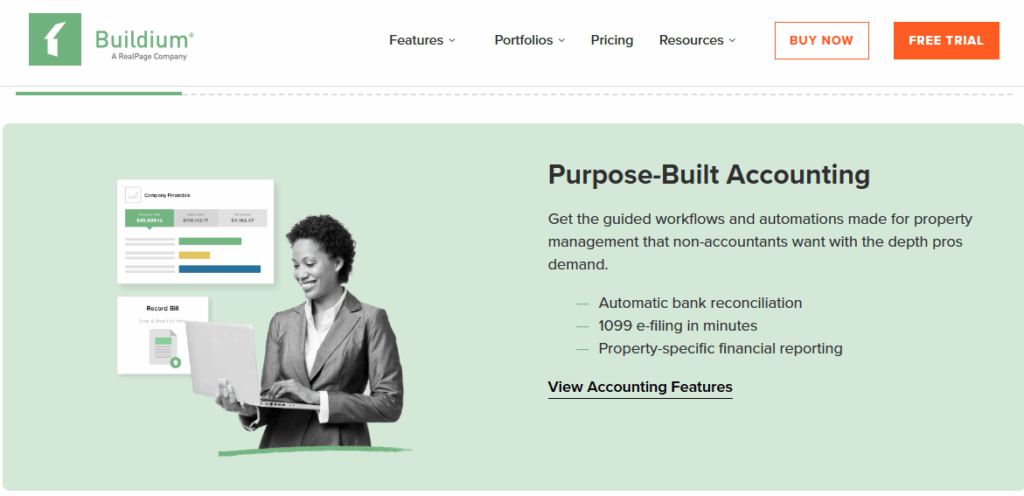
Buildium is a web-based property management system designed for managing rental properties that is accessible over the internet and includes customized functionalities.
Key features:
- Pay rent online
- Maintain a record of all your spending in a general ledger
- Screen tenants
- Submit maintenance requests
- Sign lease agreements online
- Generate owner statements tailored to your needs
- Get thorough reports..
Cost:
The most affordable option is $52 per month. Additional features and support are available with the Premium and Growth memberships.
Pros:
- Excellent property accounting skills
- A user-friendly interface that is simple to use
- Dependable customer service
- A wide range of connections.
Cons:
- The basic plans do not allow for making as many changes to credit reports
- Charges increase significantly when dealing with bigger portfolios.
Website link: https://www.buildium.com/
2. AppFolio Property Manager
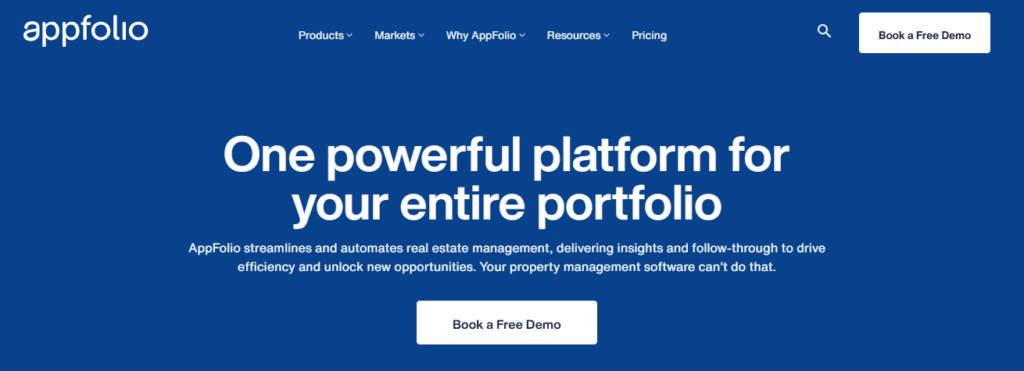
When it comes to property management software web-based applications, AppFolio is considered to be one of the top options available.
Key features:
- Online rent collection
- Extensive accounting data
- Marketing and leasing capabilities
- Management of maintenance via vendor portals
- Easy-to-use tenant interface
- A variety of reports..
Cost:
The cost of a property varies based on the kind of property, like residential, commercial, or student accommodation.
Pros:
- Excellent mobile capabilities
- Agile marketing tools
- All the features are always being included in the product.
Cons:
- Because smaller portfolios are more expensive, some clients would want to have more choices for customising certain modules
- The initial setup may take a lengthy time due to the high level of detail involved.
Website link: https://www.appfolio.com/
About to move to another residence or purchase a challenging property? Explore the best Virtual Data Rooms for Real Estate. They’ll help you share papers, do due diligence, and collaborate on projects.
3. Yardi Breeze
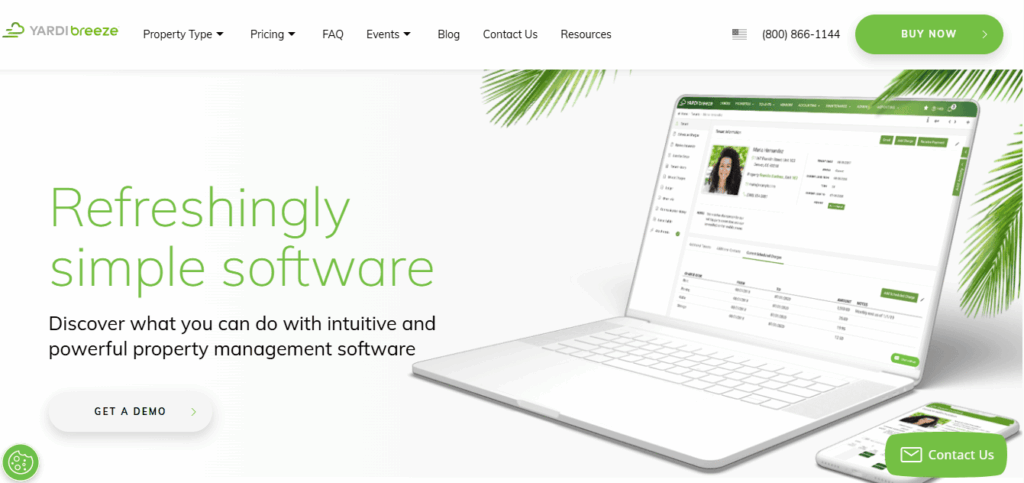
Yardi Breeze is a property management web-based software, both user-friendly and cost-effective for property managers working for small to medium-sized firms.
Key features:
- General ledger accounting
- Online portals for property owners, renters, and suppliers
- Maintenance requests
- Marketing tools
- Automated processes
- Outstanding reporting.
Cost:
The cost of each unit for residential properties starts with a dollar a month, including a minimum charge of $100. The cost for commercial and other kinds of property is subject to change.
Pros:
- Simple to use
- Reasonably priced
- Functions well for a wide variety of property types (residential, commercial, self-storage, associations)
- Exceptional support resources
- Includes a “Breeze Premier” option that allows you to access more complex features.
Cons:
- It might not have as many configuration possibilities as other enterprise-level systems
- certain sophisticated reporting capabilities would need an upgrade to Breeze Premier
- There could be fewer alternatives for integration compared to more extensive solutions.
Website link: https://www.yardibreeze.com
4. Rentec Direct
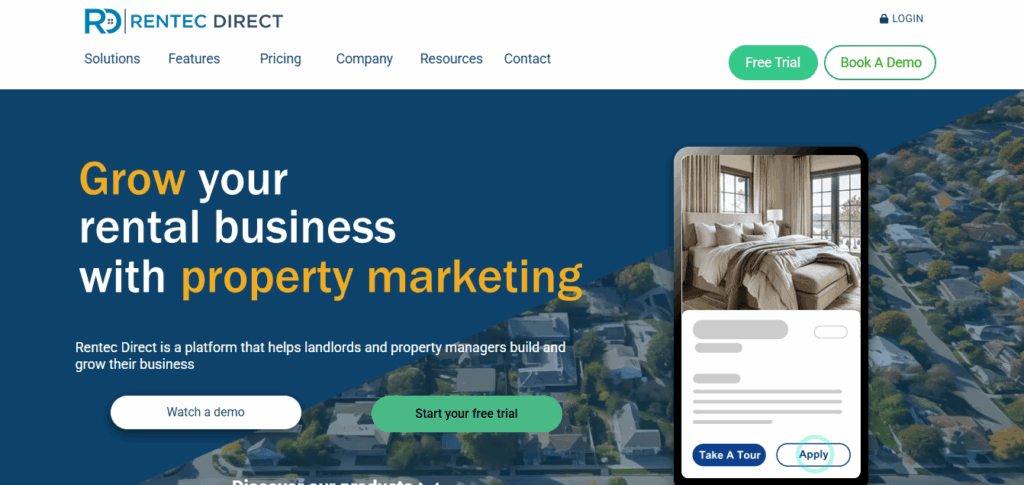
Rentec Direct is appropriate for property managers and landlords of any size.
Key features:
- Comprehensive general ledger accounting with bank reconciliation
- The ability to accept rent payments online by credit card or ACH
- Thorough background checks and tenant screening
- Advertising houses on major listing websites
- Management of maintenance requests
- Transparent financial reporting.
Cost:
Landlords who manage their own properties should expect to pay $35 per month for Rentec Pro. Rentec PM is available for $40 per month for property managers in a professional capacity.
Pros:
- Excellent customer service
- Strong accounting abilities
- Thorough tenant screening
- A user-friendly interface for managing properties
- A high degree of data security.
Cons:
- A user interface (UI) could seem to be a little outdated
- Complex procedures that need add-ons or services of a higher tier
- The mobile application may require some more development.
Website link: https://www.rentecdirect.com
5. TenantCloud
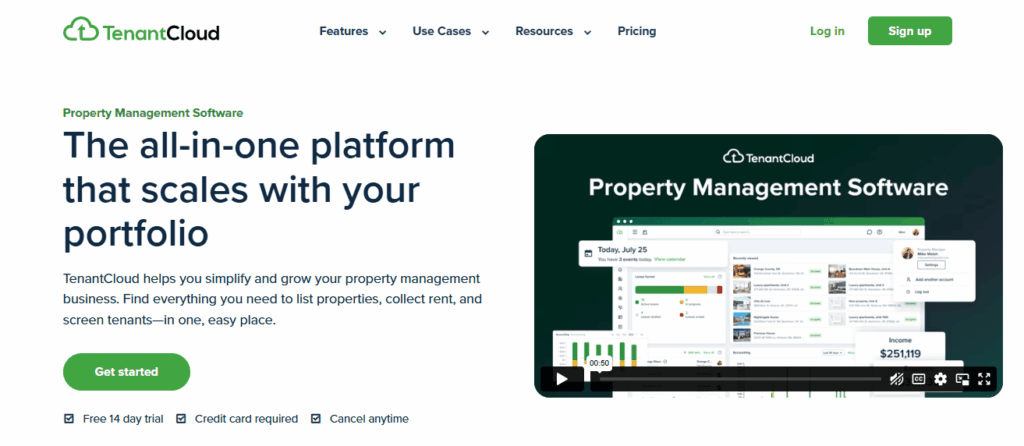
TenantCloud offers landlords and property managers the tools they need to ensure their rental properties are operating smoothly.
Key features:
- Acceptance of rent payments online (both by ACH and credit card)
- Tenant screening, maintenance requests that include photographs and videos
- Lease management and e-signing
- Accounting tools
- Free landlord forms
- Property listing syndication.
Cost:
The free plan allows you to maintain a maximum of 75 units. The monthly subscription fee for the Starter plan, including advanced capabilities, is $15.
Pros:
- Comparatively inexpensive
- Has a reasonable free tier
- Provides a large number of features for the price
- A user-friendly interface
- A dedicated tenant portal
- Constant feature updates..
Cons:
- Customer service for those who do not pay for a subscription could be slower
- Certain sophisticated capabilities are only accessible to those who subscribe to higher tiers of service
- Reporting tools may not be as comprehensive as those offered by commercial systems.
Website link: https://www.tenantcloud.com
6. Propertyware
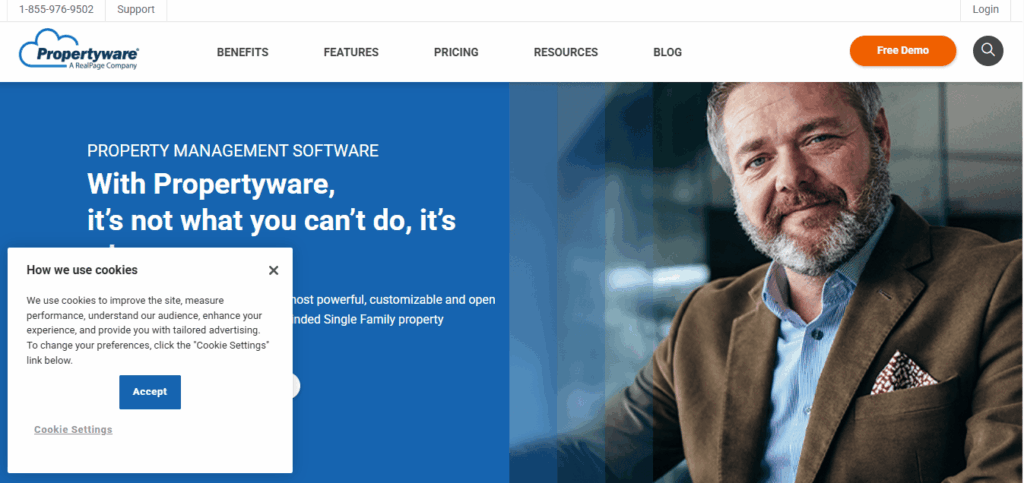
Propertyware is a cloud-based property management tool for firms that manage single-family homes.
Key features:
- You may make and utilise your own dashboards to see how your entire portfolio is doing in real time.
- Secure portals for renters to pay rent and request repairs, and for owners to see financial data.
- Use of automated procedures to make it easier to collect rent, charge late fines, and report on finances.
- Open to other web-based rental property management software systems.
Cost:
A tiered pricing system that depends on how many units you manage, with a minimum monthly fee.
- Basic: Costs $250 a month to start.
- Plus: Costs $350 a month to start.
- Premium: $450 a month or more.
All plans need a setup cost that is double the monthly subscription price.
Pros:
- Diverse options for customising it with an open API
- Sound financial information and reporting
- A plethora of features for renting out single-family homes.
Cons:
- The price is higher, and there is a big implementation charge
- Fits single-family homes, so it may not be the best choice for other kinds of properties.
Website link: https://www.propertyware.com
7. Entrata
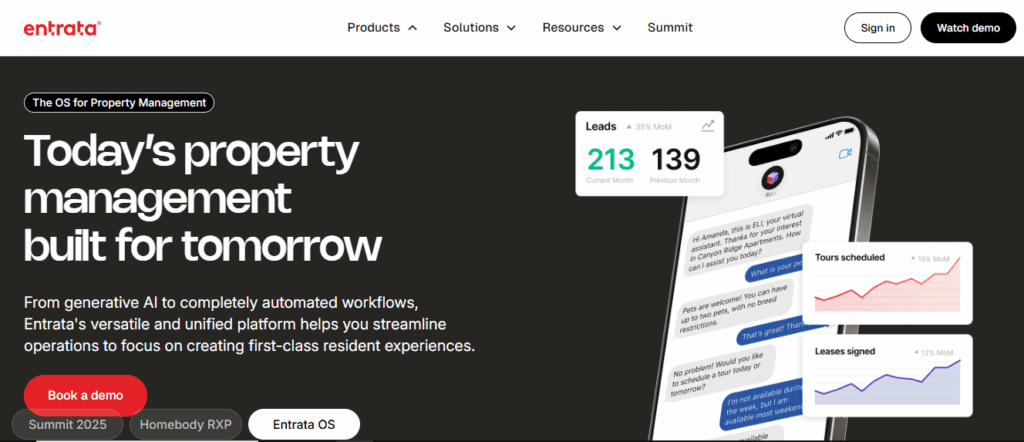
Entrata is a cloud-based custom property asset management software for multi-family rentals, equipped with everything from marketing and leasing to resident services and accounting for the whole resident lifecycle.
Core features:
- An all-in-one platform with one login to handle all parts of a portfolio, such as marketing, leasing, accounting, and utilities.
- Offers easy-to-use online solutions for those who want to rent a home and for people who already live there to pay rent.
- Takes care of everything related to buying, from dealing with suppliers to paying bills.
- Tools to keep track of inspections and maintenance requests, with an emphasis on getting back to people quickly.
Cost:
Pricing for Entrata is not posted publicly, but you may ask for it. It is based on a strategy that has been made just for the demands of the firm.
Pros:
- A complete, all-in-one platform that’s great for managing huge, complicated multifamily portfolios.
- Emphasizes the resident experience.
Cons:
- Smaller firms may find it hard to get custom pricing
- It may also take a lot of time to learn how to use all of its features.
Website link: https://www.entrata.com
8. Hemlane
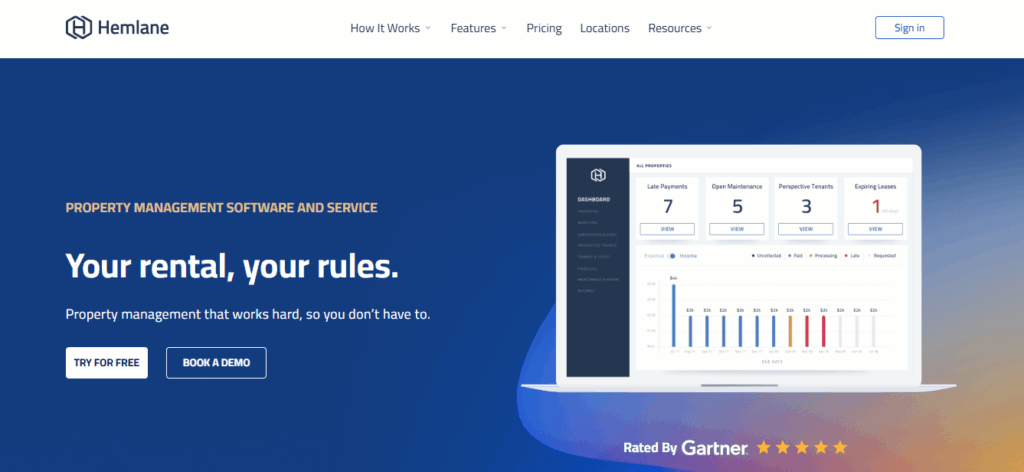
Landlords, owners, and property managers use Hemlane to automate their rental activities while still keeping complete control.
Core features:
- The model gives you tools to let you handle things on your own, but you can also add human-powered services like leasing agents and maintenance coordination.
- Automatically shares listings with more than 30 top rental sites and gives detailed information on tenant screening.
- The system automates the collection of rent and late fees and gives you tools to keep track of your revenue and expenses.
- Gives renters a way to ask for repairs, with 24/7 coordination and a network of service specialists.
Cost:
Hemlane provides several pricing plans for its software-only and software-plus-services options:
- Free (Starter): A plan that is always free for basic tenant administration and financial monitoring.
- Basic: $30 a month plus $2 per unit for things like collecting rent online and screening tenants.
- Essential: $48 a month plus $20 per unit for coordinating repairs from start to finish.
- Complete: $96 a month plus $68 per unit for complete leasing agent help.
Pros:
- Low-cost options
- Refreshingly simple software mixed with human services
- User-friendly UI.
Cons:
- The full-service plans may become expensive per unit
- Some sophisticated features are only accessible in higher-tier subscriptions.
Website link: https://www.hemlane.com
9. RealPage

RealPage makes full software solutions for the multifamily, commercial, and affordable housing markets.
Core features:
- Uses AI to make properties work better, from managing leads to setting prices and making money.
- Has a lot of different modules for marketing, leasing process, accounting, resident services, and managing facilities.
- Data-driven analytics gives you a consolidated dashboard and powerful reporting capabilities to see how your portfolio is doing in real time.
- Broad integrations: Works well with a lot of third-party apps to create a linked ecosystem.
Cost:
RealPage’s prices are tailored to each customer and may be requested.
Pros:
- Very thorough and able to handle enormous portfolios
- Has extensive data analytics and AI features
- Integrated modules soothe the entire operation.
Cons;
- Unfit for small landlords or property managers since it’s too complicated and expensive
- Too many features might be too much to handle.
Website link: https://www.realpage.com
10. MRI Software
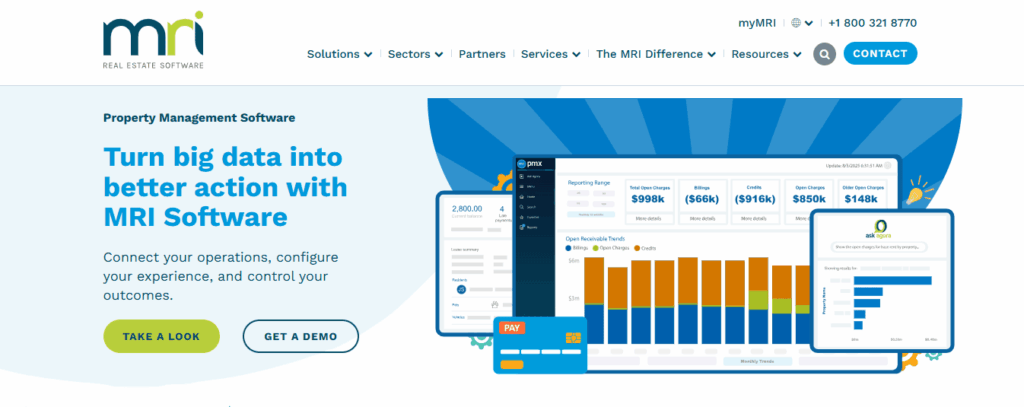
MRI Software offers a flexible and open platform for commercial, residential, and investment portfolios.
Core features:
- A flexible architecture that lets enterprises connect with a wide range of partners and customise their tech stack.
- A single platform handles a wide range of property types, like multifamily, commercial, retail, and mixed-use assets.
- The software has all the tools you need to keep track of your money, including accounting, budgeting, and financial reporting.
- Strong tools for managing leases, automating communication, and dealing with tenant demands.
Cost:
Prices are set on a case-by-case basis and may be asked for.
Pros:
- Can be used by businesses of all sizes and is very adaptable and scalable
- An open platform with many integration partners
- Has a lot of features for all sorts of properties.
Cons:
- Tedious setup process
- It may be hard for those who are new to real estate management software to understand how it works.
Website link: https://www.mrisoftware.com
How to Choose the Best Software
While choosing property management software built for your custom purposes, get systematic.
Even the best software is worthless if your staff can’t figure out how to utilise it easily. You should manage your properties from anywhere, so bet on:
- Easy-to-use interfaces
- Clear dashboards
- Mobile access.
Next, look at the main characteristics. A decent property management program should
- Handle accounting
- Ensure lease administration
- Do Rent collecting
- Maintain monitoring and reporting.
A strong solution will handle things like figuring out late fees and provide you with full financial reports.
Integrations are critical for a smooth operation. Ensure that the software integrates with the tools you use:
- CRM systems
- Secure payment gateways
- Legal compliance platforms.
Once your portfolio grows, think about scalability. The program should be able to manage a few units just as quickly as hundreds, and it should have flexible plans customized for your expansion.
Weigh up pricing packages and see whether you can afford the plan you want. Don’t forget to include the monthly price, as well as any expenses for premium features, onboarding, and per-unit charges.
Among essential features, consider sound customer support and training.
Conclusion
The real estate industry’s shift towards web-based property management tools helps businesses solve all the current pain points.
Manual paperwork, cumbersome tenant communication, disorganized rent collection, and complex compliance tracking are long-standing challenges that these platforms systematically address.
By centralizing day-to-day operations, these digital solutions automate repetitive tasks, provide seamless communication channels, facilitate secure online payments, and maintain up-to-date records.
The tech-driven transition not only streamlines daily workflows but also empowers property managers with greater oversight and control.
Adopting these tools enhances operational efficiency, improves tenant satisfaction, and provides a significant competitive advantage in a rapidly evolving market.